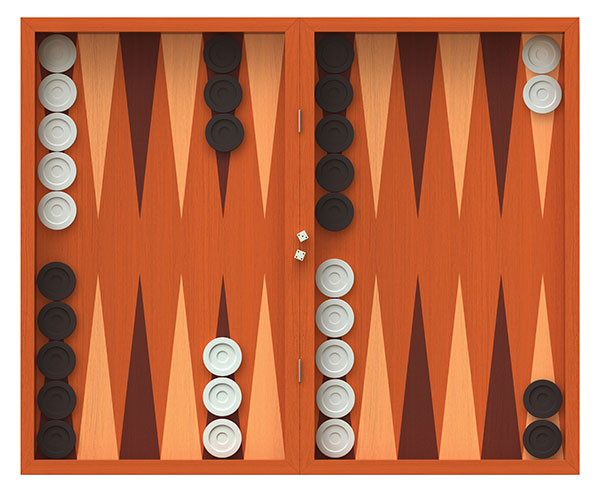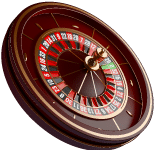Although backgammon cannot be played in a live casino, we would like to introduce you to the best board games at casino.events. Backgammon is one of the oldest board games in the world and is known and loved by many players. Similar to Poker, Backgammon is a game that has both elements of gambling (in this case dice) and strong strategic elements.
Which checkers are moved when in backgammon, when it is worthwhile to play at risk and when it is better to play it safe are questions that a backgammon master can always answer correctly, whereas a beginner relies on the luck of the dice to win.
With our game you can easily play online backgammon for free and practice against a computer or just have some fun. The HTML5 game runs in any browser and also on your smartphone.
How to play backgammon?
Backgammon is one of the oldest games for two players and has been played by people all over the world for over 5,000 years. To win at backgammon, you have to move all your checkers into your own home board and then bear them off. If you want to know how to play backgammon, just follow these simple rules.
Backgammon Rules
The pitch
Let’s take a look at the backgammon board first. Backgammon is played on a board consisting of 24 narrow triangles called points. The triangles alternate in colour and are grouped in four quadrants of six triangles each. There are four types of quadrants: the player’s home and outfield, and the opponent’s home and outfield. The intersection of these four quadrants, the center of the board, is separated by a ridge called the bar.
The players sit opposite each other on opposite sides of the board. Each player’s home board is located on the right quadrant closest to the player. The home boards face each other, as well as the outer boards, which are in the left quadrant.
Each player moves his checkers from the direction of the other player’s home board clockwise into his own home board. The triangles are numbered 1-24 on most backgammon boards, with the 24th point being the furthest point from the player and 1 being the right triangle on the player’s home board. Players must move their pieces from opposite sides of the board so that one player’s first point is the other player’s 24th point, one player’s second point is the other player’s 23rd point, and so on.
Backgammon set up
Each player must place his 15 stones to start the game. The players’ stones consist of two different colours, traditionally white and red, or white and black, but they can also be of other colours. To set up the board, each player must place two checkers on his 24 point, three checkers on his 8 point, five checkers on his 13 point and five more checkers on his 6 point.

Remember that each player has his own numbering system so that the checkers do not overlap.
In short:
- Point 24: 2 checkers
- Point 13: 5 stones
- Point 8: 3 stones
- Point 6: 5 stones
Who starts the game?
Throw a dice to see who comes out. The player who rolls the highest number starts. If both players roll the same number, roll the dice again. The two numbers rolled are considered the first moves for the player with the highest number. For example, if one player rolls a 5 and the other rolls a 2, the player who rolls the 5 would start and use the 5 and 2 for the first move.
How do you move the checkers in Backgammon?
Two six-sided dice are thrown for each move. The numbers thrown represent two separate moves. For example, if you roll a 3 and a 5, you can move one checker three spaces and another checker five spaces. Or you can move a checker by 3 squares and then move another checker by 5 more squares.
- Checkers can only be moved to an open point. An open point is any point on the board that is not occupied by two or more opposing checkers.
- You can move your checkers to a point with no checkers, a point with one or more of your own checkers on it, or a point with exactly one of your opponent’s checkers.
- Remember that you must always move your checkers counterclockwise by moving from your opponent’s home board to your own home board.
Always remember the direction of your move:
A few pointers to backgammon moves…
- You can start your move with any checker for which a valid move is possible, but it is a good idea to get your checkers out of your opponent’s home board as soon as possible.
- You only need 2 checkers to block a point, but you can have as many checkers as you like at a single point.
- Remember that you can either move one checker twice or two checkers once. For example, if you roll a 3-2, you can move a checker 3 points and then 2 points as long as it lands on an open point both times. Alternatively, you can move a checker 2 points to an open point and another checker 3 points to an open point.
Special rule for a double in backgammon
In backgammon, if you throw a double, i.e. twice the same numbers, you may make a total of four moves. For example, if you throw two threes, you can make four moves with three points each.
Loss of moves
It may happen that in backgammon you cannot make a legal move with either or both of the numbers thrown. In this case you lose your move and it is the opponent’s turn.
As a player, you are obliged to make a move if a legal move is possible. For example, if you have thrown a 3 and a 5, but can only move a checker with the 3, you must do so. Then it is the opponent’s turn.
Tip: Protect your checkers. Try to avoid that only one of your checkers stands on a point. Such single stones are called a blot. These blots are prone to being hit by your player’s checkers.
Hitting the stones
If one of the checkers is hit, it goes to bar in the middle of the field and must be entered in the opponent’s home board in the next round.
Important! Every time a checker of a player has been hit and is on the bar, he cannot move his other checkers until he has brought the checker back into play.
Moving the checkers
Stones that have been hit must be bored. The task of a player with a checker on the bar is to bring that checker back to the opponent’s home board.
It is possible to enter checkers into the opponent’s home board according to the number of a throw when the field is clear. Only after all checkers on the bar have been brought back into the game may other checkers be moved.
Bearing off the checkers in Backgammon
To win the game, you must be the first to bear off or remove all the checkers from the board.
Only when a player has borne off all his checkers to his own home board can he start bearing off (or bear off). A player bears off a checker by rolling a number corresponding to the point where the checker is located, and then removing that checker from the board. So if the player rolls a 2, he may bear off a checker from point two.
If there is no checker on the point indicated by the roll, the player must make a legal move with a checker on a higher ranking point. If there are no checkers on higher ranking points, the player may (and must) remove one checker from the highest point on which one of his checkers is located. A player is not obliged to bear off if he can make another legal move.
Important: A player must have all his active checkers in his home board to bear off. If a checker is borne off during a home roll, the player must bear that checker back to his home board before continuing to bear off. The first player to bear off all fifteen checkers wins the game.
